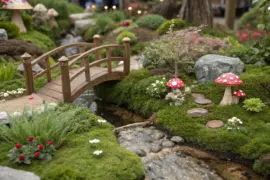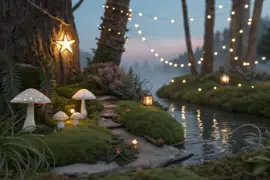Step through the frame of everyday life, and discover the enchantment waiting just beyond a tiny door.
Creating miniature portals to imaginary worlds opens up a unique space between craft and storytelling. These small doorways—nestled against a baseboard, tucked into a garden wall, or suspended within a shadow box—invite both maker and viewer to wonder what lies beyond. Whether you call them fairy doors, magical portals, or enchanted gateways, the process of building them combines accessible materials with imagination, making this an ideal project for beginners who want to explore miniature crafting without complex tools or techniques.
Starting with the Doorway Itself

The portal begins with the door, and the simplest approach uses materials you likely already have at home. Popsicle sticks or craft sticks form the foundation of most beginner-friendly designs. Lay seven or eight sticks side by side vertically, then cut two shorter pieces to glue horizontally across the back—this creates the basic structure that holds everything together. The beauty of this method lies in its flexibility: you can leave the top straight for a cottage door, or arrange the sticks in a gentle arch for something more whimsical.
If you prefer working with cardboard, that opens up even more possibilities. A sturdy piece of corrugated cardboard can be cut into any door shape imaginable—rounded, pointed, or arched. Score the cardboard lightly with a craft knife to create the illusion of wooden planks, then layer additional cardboard pieces around the opening to give your portal depth and dimension. This thickness matters; it helps the doorway feel substantial rather than flat, suggesting real passage to somewhere beyond.
For those drawn to more organic aesthetics, small twigs bound together with string or thin wire create doors that look as though they grew straight from the forest floor. The irregularity of natural materials adds character—no two doors will ever look exactly alike.
Building the Scene Around Your Portal

A doorway becomes truly magical when it exists within a setting. Even the simplest scene transforms a craft project into a tiny world.
Consider the ground beneath the door first. If you’re creating an outdoor fairy garden, small pebbles or fine gravel can be arranged as a pathway leading to the threshold. For indoor displays, air-dry clay works beautifully to sculpt a miniature stone step or landing. Roll the clay flat, press texture into it with a toothpick or piece of bark, then shape it to fit against your door before it dries.
The frame and surroundings deserve attention too. Moss—either preserved reindeer moss (which won’t grow but holds its shape beautifully) or live moss kept properly moist—softens the edges and makes the portal feel nestled into its environment. Small stones stacked or glued alongside the doorway suggest ancient walls. Tiny shells, seed pods, or dried flowers can be tucked into corners as decorative accents.
Scale matters more than you might expect. When all the elements around your door relate to each other in size, the scene feels cohesive and believable. A general guideline: if your door stands about four inches tall, choose accent pieces that would look proportional if they belonged to someone small enough to use that door—a pebble might serve as a garden stone, an acorn cap could become a planter, and a small twig transforms into a log.
Adding Texture and Realism

The difference between a craft that looks handmade and one that feels magical often comes down to texture. When everything is perfectly smooth, the eye has nowhere interesting to land. Texture creates visual richness.
Cardboard doors especially benefit from this approach. After cutting your door shape, use a ballpoint pen or a blunt tool to press wood-grain patterns into the surface before painting. These indentations catch light differently than the raised areas, and when you add color, the texture becomes even more apparent. Try painting a base coat in one color, letting it dry, then lightly dry-brushing a lighter shade over the surface so it catches only on the raised texture—instant aged wood effect.
Natural materials bring their own textures. Bark, lichen, and pinecone scales each have distinctive surfaces that add authenticity. Preserved moss comes in several varieties—sheet moss lies relatively flat, while reindeer moss has a branching, three-dimensional structure that works beautifully around door frames. Keep in mind that preserved moss won’t grow and shouldn’t be buried in soil, but it’s perfect for decorative scenes that won’t stay damp.
Hot glue itself can create texture when used thoughtfully. Applied in deliberate drips along a door frame, it mimics old paint or weather damage. For water effects around a portal that emerges near a stream or pond, clear hot glue can be built up in layers and rippled while still warm to suggest movement. Once it cools and hardens, it has a glossy, transparent quality that reads as water in miniature scale.
Lighting for Atmosphere

Light transforms a miniature portal from a static craft into something that truly glows with possibility. The smallest lights can create remarkable atmosphere without requiring complicated wiring.
Battery-powered fairy lights—also called micro LED lights or rice lights—are designed for exactly this kind of project. These tiny lights string along thin copper or silver wire that’s easy to hide, and they run on small button batteries or AA battery packs. For a doorway scene, you can tuck a single light just behind the door frame or position it to shine through a tiny window, creating the impression that someone’s home in that other realm.
If you want to avoid visible wires altogether, consider LED tea lights with their batteries already enclosed. These small, flameless candles can be tucked behind a portal or beneath a scene, casting a gentle glow upward through moss and around doorframes. For outdoor garden installations where you want evening magic, small solar-powered garden lights can be partially buried near your door so only the glow shows after dark.
The color of light matters too. Warm white or amber LEDs suggest candlelight and feel cozy and inviting. Cool white creates a more mysterious, moonlit atmosphere. Some fairy light sets come with color options—soft blue or green can make a portal feel especially otherworldly.
Beings & Creatures: Friendly Inhabitants

No magical realm feels complete without at least a hint of who might live there. Simple miniature creatures add personality to your portal without requiring advanced sculpting skills.
Air-dry clay makes this accessible for beginners. Start with basic shapes: a ball for a body, smaller balls for heads and limbs. A friendly snail can be created by rolling clay into a simple coil for the shell and a teardrop shape for the body. Small birds are just rounded bodies with pinched beaks and tiny wings pressed onto the sides. Forest creatures like hedgehogs, rabbits, or mice work beautifully near enchanted doors—their small scale feels naturally proportional.
Simple details bring these creatures to life. Press the tip of a toothpick into the clay to create eyes, or use tiny seed beads pushed in before the clay dries. Texture a hedgehog’s back with repeated small pokes of a toothpick to suggest spines. For a bunny, roll two small ovals and press them onto the head as ears.
Keep these creatures child-friendly and gentle in character. Owls with big eyes, butterflies resting on flowers, friendly mice peeking from doorways, frogs sitting on stones—these inhabitants suggest kindness and curiosity rather than anything alarming. If you’re crafting with children, let them decide what lives beyond their portal: perhaps tiny unicorns, gentle dragons, or woodland sprites.
The Magic Behind the Door
What makes a portal compelling isn’t just the door itself—it’s the suggestion of what lies beyond. This is where storytelling and craft beautifully merge.
For doors attached to walls (indoors or outdoors), you might leave the space behind mysterious, inviting viewers to imagine their own version of the magical realm. Alternatively, cut a small opening in your door so it can swing open, revealing a tiny scene behind it—a glimpse of another world. This hidden element creates surprise and deepens engagement, especially for children who discover it.
Some crafters create entire miniature landscapes behind their portals using shadow boxes or recessed frames. A small printed image or hand-drawn scene can be mounted behind the doorway—a starry sky, an enchanted forest, or an underwater cavern. The door becomes a literal window into that realm.
Even simpler approaches work beautifully: leaving tiny “evidence” near the door suggests recent visitors. A trail of glitter (fairy dust), miniature footprints pressed into clay, a thimble-sized basket, or a note written in tiny letters all hint at the magical inhabitants without showing them directly. This approach invites ongoing storytelling—you can change what appears by the door over time, creating an evolving narrative.
Finishing with a Touch of Magic
The final details often make the biggest difference between a craft that looks complete and one that feels truly enchanted.
Consider adding small hinges to your door—even if they’re decorative rather than functional. Tiny metal hinges, or ones cut from craft foam and painted metallic, immediately make a door look more authentic. A doorknob or handle is equally important; a small bead, button, or even a tiny knot of wire serves this purpose.
Signage adds character too. A miniature house number made from wire, a tiny carved “welcome” sign, or even a minuscule wreath on the door suggests intentional habitation. These don’t need to be complicated—creativity matters more than precision.
For outdoor installations, weatherproofing extends the life of your portal. Seal wooden or cardboard doors with outdoor-grade Mod Podge or a water-based polyurethane. This protective layer helps them survive rain and humidity, though no small craft will last forever outside—think of them as seasonal enchantments that might need refreshing each year.
Finally, placement completes the magic. A door placed at baseboard level along a hallway invites everyday wonder. One nestled among garden plants creates a secret hideaway. In a child’s room, a portal beside the bed becomes a personal gateway to imagination. The location you choose shapes how the portal is discovered and what stories it might inspire.
Beginning Your Own Portal
The beauty of these miniature doorways lies in how accessible they are—no special training or expensive materials required, just curiosity and willingness to play with scale and story. Start simple: a few popsicle sticks, some paint, a button for a handle, and you have a door. From there, the project grows as your interest directs—adding moss, sculpting a tiny creature, wiring a light, building a scene.
Every magical portal begins with the same quiet question: what if? What if this door actually opened? What if someone small enough to fit through it really did come visiting? What realm would you most want to discover on the other side? The answers to those questions will guide your hands as you craft, and the resulting doorway—small as it is—becomes an invitation to wonder that can fit anywhere at all.





